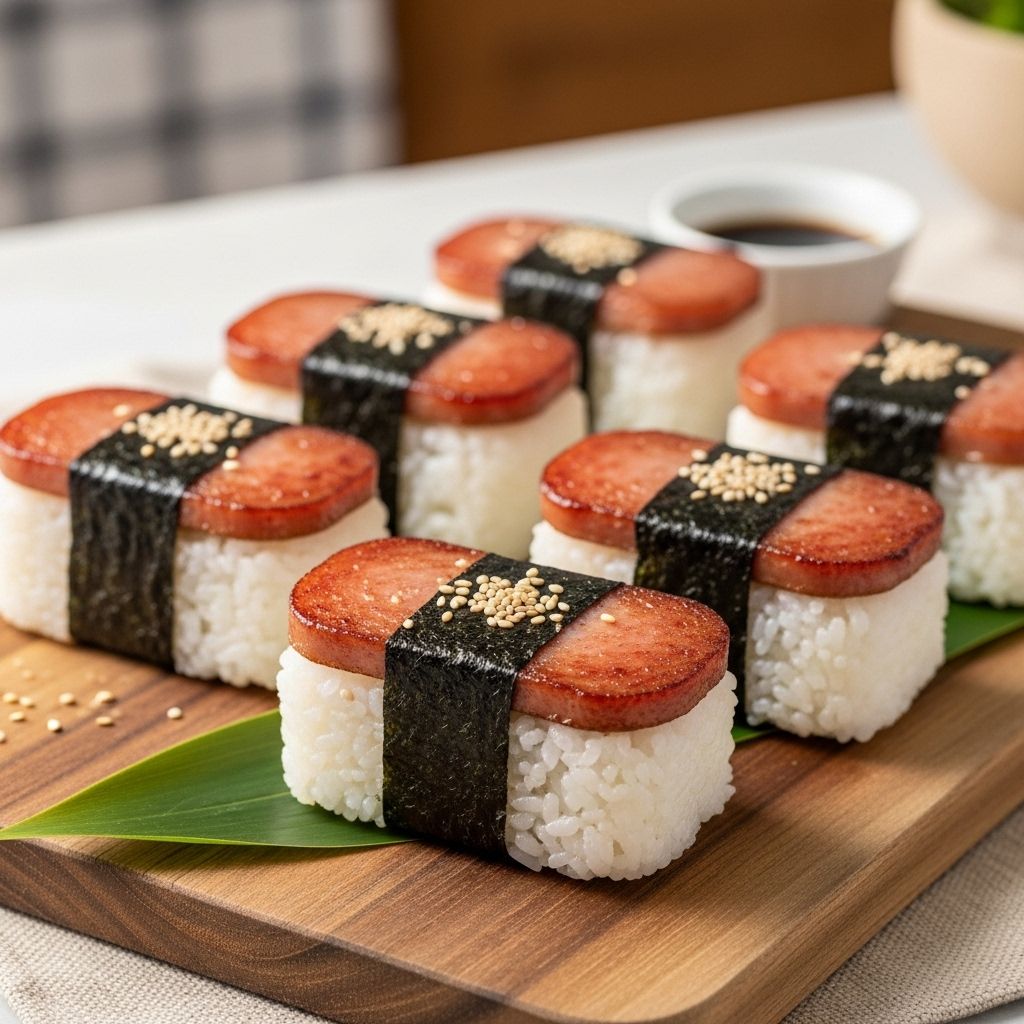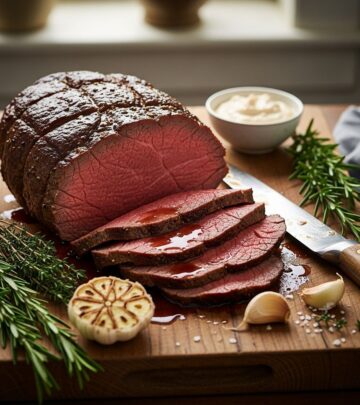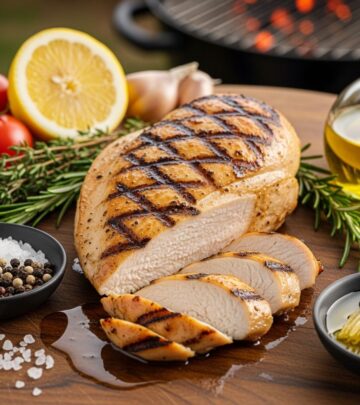Spam Musubi Recipe: 5 Easy Steps For Authentic Hawaiian Snack
Discover how to make authentic Spam Musubi at home, blending salty-sweet flavors and Hawaiian tradition in an easy-to-love snack.

Image: HearthJunction Design Team
Spam Musubi: The Beloved Hawaiian Snack You Can Make at Home
Spam musubi is an iconic Hawaiian snack that masterfully blends Asian and American influences into a delicious, portable treat. With slices of savory seared Spam, perfectly seasoned sushi rice, and a crisp nori wrap, it’s both deeply comforting and easy to customize. This detailed guide will introduce you to Spam musubi’s origins, ingredients, preparation, and creative serving ideas so you can confidently make this crowd-pleasing snack at home.
What Is Spam Musubi?
Spam musubi is a popular snack and lunch food in Hawaii, featuring grilled or seared Spam on a block of seasoned sushi rice, all wrapped securely in a strip of nori (dried seaweed). Often likened to a sushi roll but without raw fish, Spam musubi offers a satisfying sweet-and-salty bite that’s perfect for on-the-go meals, picnics, or lunchboxes. The snack’s roots are deeply embedded in Hawaii’s culinary culture, reflecting both Japanese musubi (rice balls) and the widespread popularity of Spam in the islands since World War II.
History and Cultural Significance
Spam, a canned, precooked meat product from Hormel, became a staple in Hawaii during WWII when fresh meat was scarce. Its versatility and shelf-stable qualities made it a pantry essential. Spam musubi emerged in the mid-20th century when creative home cooks, notably Barbara Funamura of Kauai, layered slices of Spam with rice, shaped everything into a compact block, and wrapped it in nori. Today, Spam musubi is ubiquitous across Hawaii, served at convenience stores, potlucks, parties, and bento boxes alike.
Why Spam Musubi Endures
- Affordability: Uses inexpensive, widely available ingredients.
- Portability: Easy to pack for picnics, school, or work lunches.
- Flavor: Balances salty, sweet, and umami tastes in a satisfying bite.
- Tradition: A nostalgic comfort food for many Hawaiian families.
Ingredients
Traditional Spam musubi uses a short list of simple ingredients, with optional seasonings or variations to suit your tastes. Here’s what you’ll need for 10 servings:
- 2 cups uncooked short-grain white rice – Sushi or Calrose rice is preferred for its stickiness.
- 2 cups water – For cooking the rice.
- 6 tablespoons rice vinegar – Seasons and adds tang to the rice.
- ½ cup white sugar – For a lightly sweet taste.
- ¼ cup soy sauce – Brings umami depth to the marinade.
- ¼ cup oyster sauce – Adds sweetness and savoriness.
- 1 (12-ounce) can Spam – Classic, but low-sodium or flavored versions also work.
- 2 tablespoons vegetable oil – For frying Spam slices.
- 5 sheets sushi nori – Dry seaweed, cut in half to make 10 strips.
Optional: Furikake (a Japanese rice seasoning blend of sesame seeds, seaweed, and dried fish) to sprinkle between the rice and Spam for extra flavor.
Equipment You May Need
- Rice cooker or saucepan
- Musubi mold (optional, but helpful for shaping)
- Sharp knife
- Mixing bowls
- Skillet or frying pan
Step-by-Step Instructions
1. Prepare the Rice
- Start by soaking the uncooked short-grain white rice in water for about 4 hours. This step helps ensure the rice cooks evenly and sticks together well.
- Drain and rinse the rice, then add it to a saucepan with 2 cups of water. Bring to a boil, stir, reduce heat, cover, and simmer for 20 minutes until the water is absorbed and the rice is tender.
- Remove the rice from heat and stir in 6 tablespoons of rice vinegar. Let the rice cool while you prepare the Spam.
2. Make the Marinade & Prepare the Spam
- In a bowl, mix together ½ cup white sugar, ¼ cup soy sauce, and ¼ cup oyster sauce until the sugar dissolves. This creates a sweet and savory glaze.
- Slice the Spam lengthwise into 10 even slices (about ¼–½ inch thick). You can adjust thickness to preference.
- Place Spam slices in the marinade and soak for at least 5 minutes, turning so they’re coated. For extra flavor, marinate up to 15–30 minutes.
3. Fry the Spam
- Heat 2 tablespoons vegetable oil in a skillet over medium-high heat.
- Add Spam slices and cook each side for about 2 minutes, or until lightly browned and caramelized. Reserve any extra marinade for drizzling, if desired.
4. Assemble the Musubi
- Cut nori sheets in half to yield 10 strips.
- Lay a strip of nori shiny side down on a clean, dry surface.
- If using a musubi mold: Place the mold in the center of the nori. Press a layer of seasoned rice into the bottom, about 1 to 1½ inches thick. Wet your fingers or the mold with water to prevent sticking.
- Optional: Sprinkle furikake over the rice for added flavor.
- Top the rice with a cooked Spam slice. Carefully remove the mold if using.
- Wrap the ends of the nori over the top of the Spam and rice, sealing the edge with a dab of water to help it stick.
- If you don’t have a musubi mold, use your hands to shape the rice into rectangles about the same size as the Spam slices.
5. Serve
- Spam musubi can be enjoyed warm, at room temperature, or chilled.
- For a neater presentation, wrap each piece in plastic wrap for grab-and-go eating, or serve on a platter.
Tips for Success
- Use the right rice: Short-grain or sushi rice is essential for the stickiness needed to keep musubi together.
- Wet your hands and tools: Prevent rice from sticking by keeping your hands and molds damp as you work.
- Adjust marinade to taste: Want it sweeter or saltier? Tweak the balance of sugar, soy sauce, and oyster sauce to suit your palate.
- Seal nori firmly: Use a bit of water on your finger to help the seaweed adhere securely.
- Serve soon after making: Nori can become chewy as it sits, so musubi is best enjoyed within several hours.
Variations and Additions
- Furikake musubi: Add a layer of furikake seasoning for a nutty, savory twist.
- Egg musubi: Layer a thin omelet slice between the rice and Spam.
- Sriracha or chili mayo: Drizzle with spicy condiments for added heat.
- Avocado: Add thin avocado slices for creamy richness.
- Bacon: For a breakfast version, sandwich a strip of bacon with the Spam.
- Brown rice: Substitute for added fiber and flavor (though stickiness may be less).
Serving Ideas and Storage
- Spam musubi is perfect for picnics, potlucks, office lunches, or beach days.
- For lunchboxes, wrap musubi individually in parchment or plastic to keep them fresh.
- If making ahead, store wrapped musubi in the refrigerator for up to a day. For the best texture, let come to room temperature or briefly microwave before eating.
Nutritional Information
Spam musubi is a treat best enjoyed in moderation, as Spam is high in sodium and fat. Each serving contains a balance of carbohydrates (from rice), protein (from Spam), and some fat. Using lower-sodium Spam or less sugar in the marinade can make the snack a bit lighter.
Frequently Asked Questions (FAQs)
Q: Can I make Spam musubi ahead of time?
A: Yes! Spam musubi keeps well for up to 24 hours if wrapped tightly and refrigerated. For the best texture, let it come to room temperature before eating, or microwave briefly to warm.
Q: What can I use if I don’t have a musubi mold?
A: A musubi mold creates uniform rectangles, but you can shape the rice by hand. Wet your palms to prevent sticking and gently press rice into a compact block the same size as your Spam slices.
Q: Can I use flavored Spam?
A: Absolutely! Variants like teriyaki, jalapeño, or bacon-flavored Spam add fun twists. Adjust the marinade to match the flavor profile if you like.
Q: Can I make Spam musubi gluten-free?
A: Yes, by using gluten-free soy sauce (such as tamari) and making sure your oyster sauce is also gluten-free.
Q: Do I need to use sushi-grade rice vinegar?
A: While authentic sushi rice uses rice vinegar, you can substitute with apple cider vinegar in a pinch, though the flavor will change slightly.
Fun Facts About Spam Musubi
- Spam musubi is so popular in Hawaii that you’ll find it at gas stations, school cafeterias, and even high-end restaurants.
- Hawaii consumes more Spam per capita than any other state in the U.S.
- There are annual Spam festivals in Hawaii, where musubi takes center stage!
Spam Musubi At-A-Glance
| Component | Description | Tips |
|---|---|---|
| Spam | Fried, marinated slices | Marinate longer for deeper flavor |
| Rice | Sticky short-grain, seasoned | Use sushi-grade for best results |
| Nori | Seaweed, roasted | Wrap tightly; use water to seal |
| Seasoning | Furikake (optional) | Add for extra umami |
Conclusion
Spam musubi is much more than a simple snack—it’s a culinary symbol of Hawaii’s resourcefulness, multicultural heritage, and love of good food. With its easy assembly, adaptability, and comforting flavors, it’s no wonder Spam musubi has remained a favorite for generations. Whether you’re new to this dish or a lifelong fan, making Spam musubi at home is an invitation to share a little bit of Hawaii’s snack culture, wherever you are.
References
Read full bio of Srija Burman












